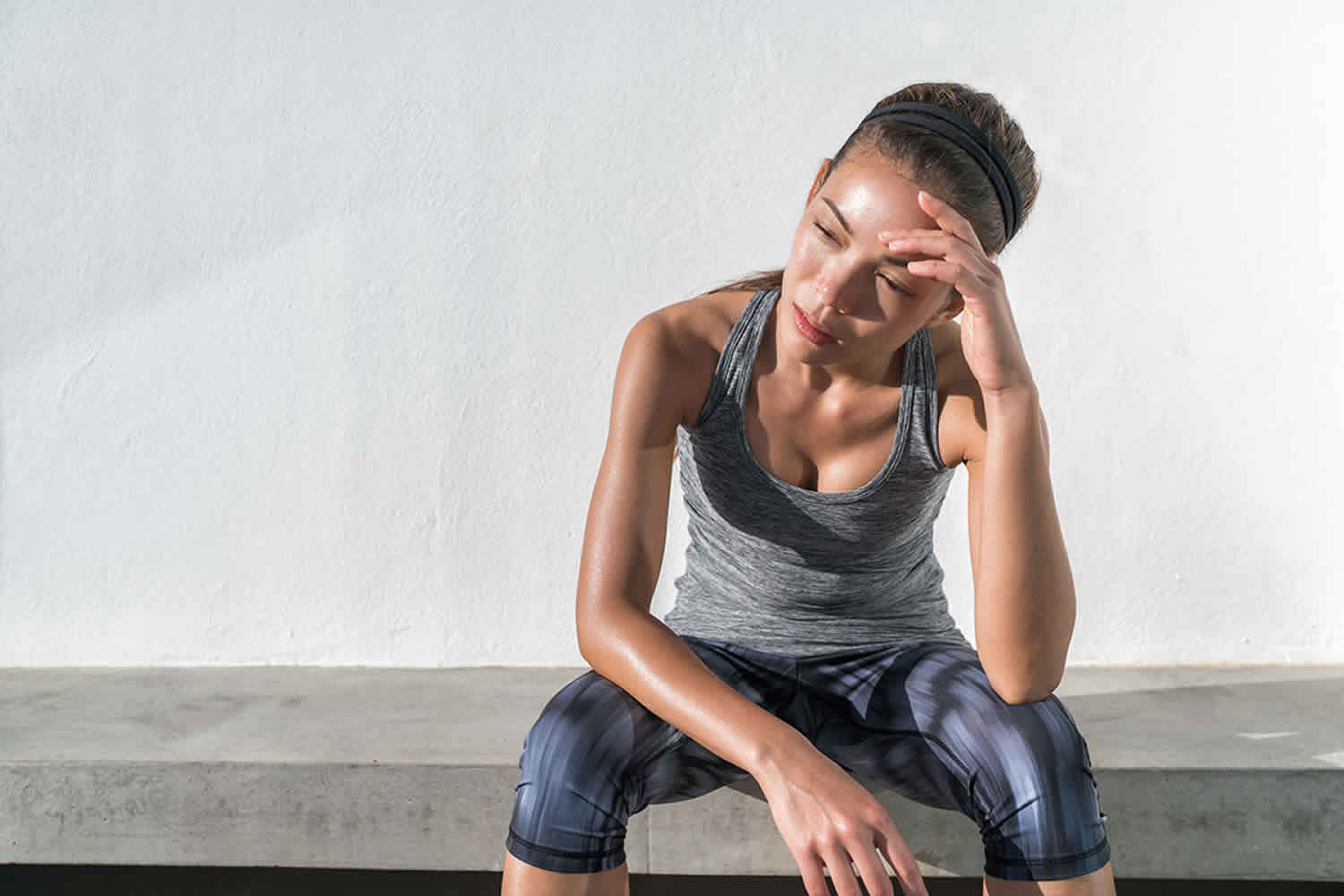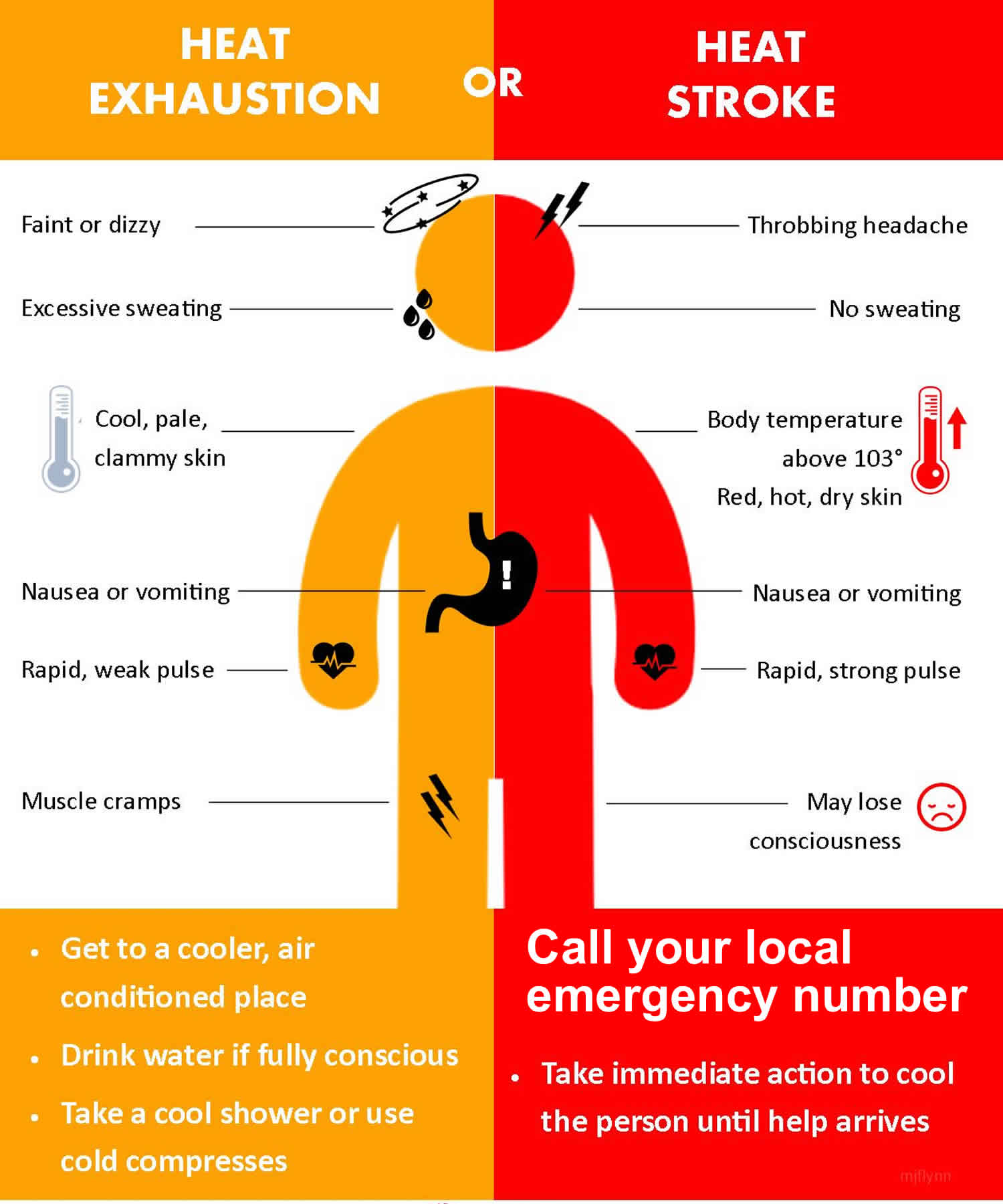What is heat exhaustion
Heat exhaustion is the moderate form of heat illness that happens when your body gets too hot and usually gets better when you cool down. Heat illness occurs when a person’s core body temperature rises above a safe level of the body’s internal temperature range. Heat cramps are the earliest sign of heat illness. If precautions to cool off and rehydrate at this point are not made, the more severe stage of heat illness, heat exhaustion, can occur in a rapid progression. The progression from the early stage of heat illness to heat exhaustion and subsequently to heatstroke can be very quick and can result in a potentially life-threatening situation.
Heat exhaustion starts slowly, but if it’s not quickly treated it can progress to heatstroke. Heat stroke is an emergency. Heat stroke occurs when the body is no longer able to regulate its temperature, and it keeps rising. Heat stroke can cause shock, brain damage, organ failure and brain damage. In extreme cases, heatstroke can kill you. In heatstroke, a person’s temperature reaches 105°F (40.5°C) or higher. Heatstroke requires immediate emergency medical care and can be life-threatening.
Babies, children, the elderly and people with long-term health conditions (like diabetes or heart problems) are more at risk of heat exhaustion or heat stroke. You also are at greater risk if you are ill or obese, or have heart disease. People who work outside or in a hot setting also are at risk of heat exhaustion and heatstroke.
The signs of heat exhaustion include:
- intense thirst or increased thirst
- headache
- dizziness and confusion
- loss of appetite and feeling sick
- excessive sweating and pale, cool, clammy skin
- cramps in the arms, legs and stomach
- fast breathing or pulse
- temperature of 100.4 °F (38 °C) or above, but to less than 105°F (40.5°C)
- weakness and extreme tiredness
- fainting
- nausea and vomiting
- irritability
- increased sweating
- fast heartbeat
- dark-colored urine, which indicates dehydration.
The symptoms are often the same in adults and children, although children may become floppy and sleepy.
If someone is showing signs of heat exhaustion they need to be cooled down.
Signs and symptoms of heatstroke:
- severe headache
- weakness, dizziness
- fainting
- confusion
- fast breathing and heartbeat
- loss of consciousness (passing out)
- seizures
- little or no sweating
- flushed, hot, dry red skin
- body temperature rises to 105°F (40.5°C) or higher
Call your local emergency services number if the person:
- is no better after 30 minutes
- feels hot and dry
- is not sweating even though they are too hot
- has a temperature that’s risen to 104 °F (40 °C) or above
- has rapid or shortness of breath
- is confused
- has a fit (seizure)
- loses consciousness
- is unresponsive
These can be signs of heat stroke.
While you wait for help, keep giving first aid and put them in the recovery position if they lose consciousness.
How to treat heat exhaustion
Things you can do to cool someone down.
Follow these simple steps:
- Move them to a cool place — bring the person indoors or into the shade immediately
- Get them to lie down and raise their feet slightly, about 12 inches (30 centimeters).
- Get them to drink plenty of water. Sports or rehydration drinks are okay. Or make a salted drink by adding a teaspoon (6 grams) of salt per quart (1 liter) of water. Give a half cup (120 milliliters) every 15 minutes. Cool water will do if salt beverages are not available.
- Cool their skin – spray or sponge them with cool water or apply cool water directly to their skin or take a cool bath and use a fan to lower body temperature. Cold packs around the armpits or neck are good too.
- For muscle cramps, give beverages as noted above and massage affected muscles gently, but firmly, until they relax.
- If the person is vomiting, turn onto his or her side to prevent choking.
Stay with person until they are better. They should start to cool down and feel better within 30 minutes. If the person shows signs of shock (bluish lips and fingernails and decreased alertness), starts having seizures, or loses consciousness, call your local emergency services number and you also should begin CPR (cardiopulmonary resuscitation) right away to try and revive them.
- DO NOT give the person medicines that are used to treat fever (such as aspirin or acetaminophen). They will not help, and they may be harmful.
- DO NOT give the person salt tablets.
- DO NOT give the person liquids that contain alcohol or caffeine. They will make it harder for the body to control its internal temperature.
- DO NOT use alcohol rubs on the person’s skin.
- DO NOT give the person anything by mouth (not even salted drinks) if the person is vomiting or unconscious.
What causes heat exhaustion?
Heat-related illnesses occur when your body can’t keep itself cool. As the temperature rises, your body dissolves sweat to stay cool. On hot, humid days, the increased moisture in the air slows down this process. When your body can’t cool, your temperature rises and you can become ill.
You are more likely to feel the effects of heat sooner if:
- You are not used to high temperatures or high humidity.
- You are a child or an older adult.
- You are already ill from another cause or have been injured.
- You are obese.
- You are also exercising. Even a person who is in good shape can suffer heat illness if warning signs are ignored.
The following make it harder for the body to regulate its temperature, and make a heat emergency more likely:
- Drinking alcohol before or during exposure to heat or high humidity
- Not drinking enough fluids when you’re active on warmer or hot days
- Heart disease
- Certain medicines: Examples are beta-blockers, water pills or diuretics, some medicines used to treat depression, psychosis, or ADHD
- Sweat gland problems
- Wearing too much clothing
Hot weather and exercise are the main causes of heat exhaustion and heatstroke. In hot settings, you need to be mindful of the temperature outside. The heat index is not the same as the temperature. It measures the air temperature plus the effects of humidity. A heat index of 90°F (32.2 °C) or higher is dangerous. Prolonged exposure to high temperatures increases your risk of heat-related illnesses.
Certain medicines can put you in danger of heatstroke. They affect the way your body reacts to heat. Talk to your doctor if you take any of these or have an ongoing health problem. They can help you manage the heat with your condition. These medicines include:
- Antibiotics.
- Allergy medicines (antihistamines).
- Some medicines used to manage blood pressure, cholesterol, and heart disease (beta-blockers and vasoconstrictors).
- Some medicines that treat mental health problems (antidepressants and antipsychotics).
- Seizure medicines (anticonvulsants).
- Water pills (diuretics).
- Laxatives.
- Some diet pills.
- Prescription acne medicines.
- Illegal drugs, such as cocaine (amphetamines).
Heat exhaustion prevention
There is a high risk of heat exhaustion or heat stroke during hot weather or exercise.
To help prevent heat exhaustion or heat stroke:
- Don’t go outside when the temperature and heat index are high. If possible, stay indoors in air-conditioned areas.
- Always drink plenty of cold drinks before and during any activity in hot, sunny weather — even if you aren’t thirsty. Dehydration and lack of salt contribute to heat-related illnesses. Some sports drinks can help replenish the salt in your body lost through sweating. Drink water or other fluids every 15 to 20 minutes, even if you don’t feel thirsty. If your urine is clear, you are probably drinking enough fluids. Dark-colored urine is a sign that you’re dehydrated.
- Make sure you wear light-colored, loose clothing in warm weather.
- Sprinkle water over skin or clothes.
- Protect yourself from the sun by wearing a hat or using an umbrella.
- Use sunscreen with a sun protection factor (SPF) of 30 or higher.
- Look for shaded areas and rest often while outside.
- Don’t participate in heavy activity outdoors during the hottest hours of the day, between 11am and 3pm.
- Schedule outdoor activities for cooler times of the day — before 10 a.m. and after 6 p.m.
- Come indoors immediately whenever you feel overheated.
- Take frequent breaks from the heat and outdoor activities.
- Take cool baths or showers.
- Avoid or limit drinks that contain caffeine (such as tea, coffee, and soda) or alcohol.
- Do not stay or leave a child in your car when it is hot out. Even if you open the windows, the intense heat can be extremely dangerous.
Heat exhaustion signs and symptoms
The signs of heat exhaustion include:
- intense thirst or increased thirst
- headache
- dizziness and confusion
- loss of appetite and feeling sick
- excessive sweating and pale, cool, clammy skin
- cramps in the arms, legs and stomach
- fast breathing or pulse
- temperature of 100.4 °F (38 °C) or above, but to less than 105°F (40.5°C)
- weakness and extreme tiredness
- fainting
- nausea and vomiting
- irritability
- increased sweating
- fast heartbeat
- dark-colored urine, which indicates dehydration.
The symptoms are often the same in adults and children, although children may become floppy and sleepy.
If someone is showing signs of heat exhaustion they need to be cooled down.
How is heat exhaustion diagnosed?
If a person is displaying known heat illness signs and symptoms, take their temperature. A reading of 104°F (40 °C) or more means they probably have heatstroke. You should call your local emergency services number and get medical care right away.
Heat exhaustion recovery
A person suffering from heat exhaustion should start to cool down and feel better within 30 minutes.
Call your local emergency services number for an ambulance if:
- Symptoms don’t improve or they still have a fever of 102°F (39 °C) after 30 minutes of initial treatment.
- The person goes into shock, faints, or has seizures.
- The person is not breathing. You also should begin CPR (cardiopulmonary resuscitation) right away to try and revive them.
After effects heat exhaustion
After you’ve had heat exhaustion or heatstroke, you will be sensitive to heat. This can last for about a week. It’s important to rest and let your body recover. Avoid hot weather and exercise. Ask your doctor when it’s safe to return to your normal activities.
Heat exhaustion treatment
If you or someone else has heat exhaustion, treat symptoms in the following ways.
- Get out of the heat quickly and into a cool place, or at least shade.
- Lie down and elevate your legs [about 12 inches (30 centimeters)] to get blood flowing to your heart.
- Take off any tight or extra clothing.
- Apply cool wet towels or cool water directly to your skin or take a cool bath. This will help regulate and lower your internal body temperature.
- Place cold compresses on the person’s neck, groin, and armpits.
- Drink fluids, such as water or a sports drink. Do not drink fluids with caffeine or alcohol. Sports or rehydration drinks are okay. Or make a salted drink by adding a teaspoon (6 grams) of salt per quart (1 liter) of water. Give a half cup (120 milliliters) every 15 minutes. Cool water will do if salt beverages are not available.
- For muscle cramps, give beverages as noted above and massage affected muscles gently, but firmly.






